Fun Chinese Activities to Learn Speaking, Reading, and Writing
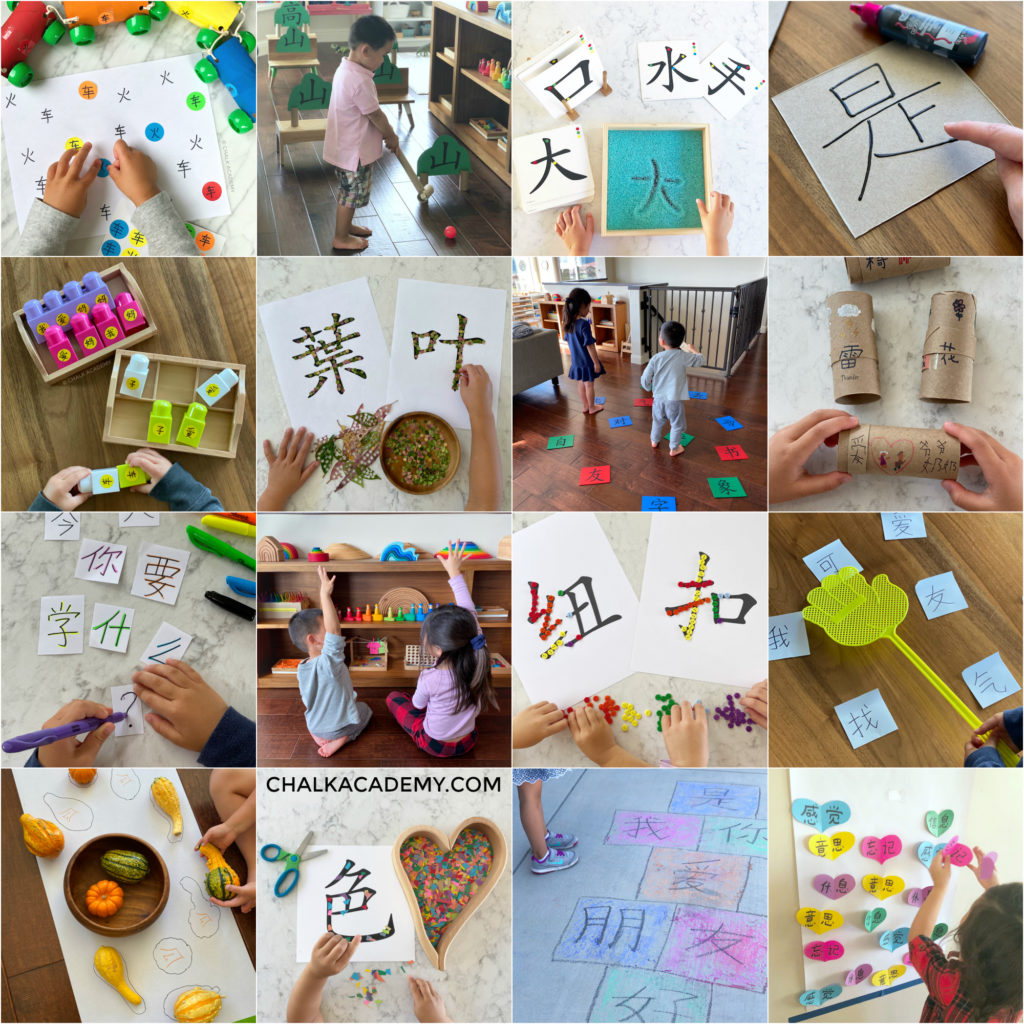
Wondering how to make Chinese fun and memorable? The best way to teach kids Chinese is by connecting with your child and creating fun memories. Whether you’re working on speaking, reading, or writing, Chinese learning activities can greatly help.
When English is the dominant community language, a child knows that Chinese is not “necessary.” So, if you’re teaching a second language, it needs to be extra exciting. Old-fashioned tactics like shaming and yelling are surefire ways to make a child hate Chinese.
Thankfully, there are lots of better ways to learn. I’ve been teaching my children Chinese for nearly a decade, and here are 35 easy, low-prep Chinese learning activities that you can do at home or school. See which idea your child loves the most.
Chalk Academy is reader-supported. Some of the links are affiliate links. When you buy something through an affiliate link, we may earn a very small commission at no cost to you. Details here.
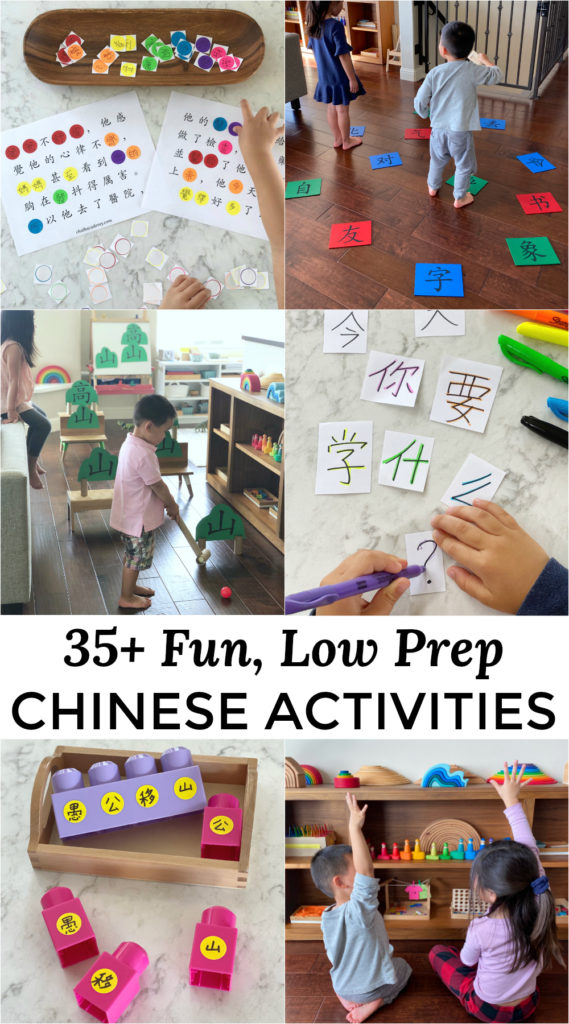
What can kids learn from Chinese activities?
Chinese language activities and games have been a regular part of our routine since we decided to raise multilingual children. We’ve practiced Chinese listening, speaking, reading, and writing.
Listening and speaking Chinese are the most important skills to prioritize at any age. Reading and writing can be considered when kids have solid verbal communication skills.
Kids develop at different rates; some might be ready to explore literacy around age 3, while most will be closer to ages 5 to 7.
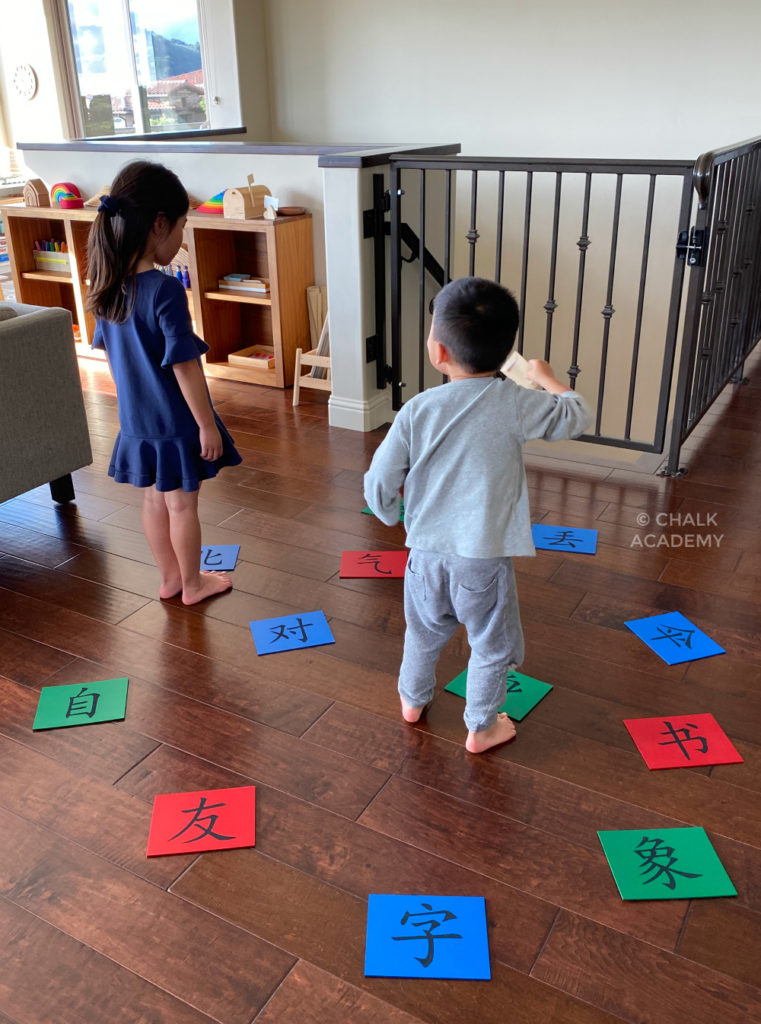
The easiest Chinese learning activities for kids
To save you time, I combed my website for activities that fit the following criteria:
- Easy set up (less than 5 minutes)
- Minimal supplies
- Fun
- Reusable
- Adaptable to different ages and fluency levels
These activities can jump-start Chinese learning or rebuild momentum if you’re in a slump. If you need to take that important phone call or do some other work, your child can work beside you with simple activities.
In addition, many of these options involve gross motor movement, which can help kids get much-needed exercise! Search for Chinese activities by topic here, or keep scrolling for easy, versatile activities!
Recommended supplies
Most of the activities can be done with supplies you have at home. In addition, just a few materials are convenient to keep on hand:
- Dot stickers (Garage sale pups (left) and Avery labels (right)
- Index cards
- Paper
- Post-it Notes
- Painter’s tape
- Thick black marker (eg, Sharpie)
Tips for getting started
- Incorporate your child’s interests and opinions
- Demonstrate how to do activities verbally and physically

Fun activities for Chinese listening and speaking
Listening and speaking are the foundation of Chinese learning and communication skills. Here are fun ways to reinforce Chinese audio and verbal skills at home!
1. Dance Party / Freeze Dance

Start the day with upbeat Chinese music and have a silly dance-off! Play freeze dance during which the DJ stops the song randomly, and everyone has to 停 (tíng / stop) and 不要动 / 不要動 (bùyào dòng / don’t move)!
Explore this: Best Chinese Children’s Songs and Nursery Rhymes
2. Karaoke
Sing and learn a new Chinese song each week with these printable song lyrics in simplified (with and without pinyin) and traditional Chinese!
3. I spy with my little eye…
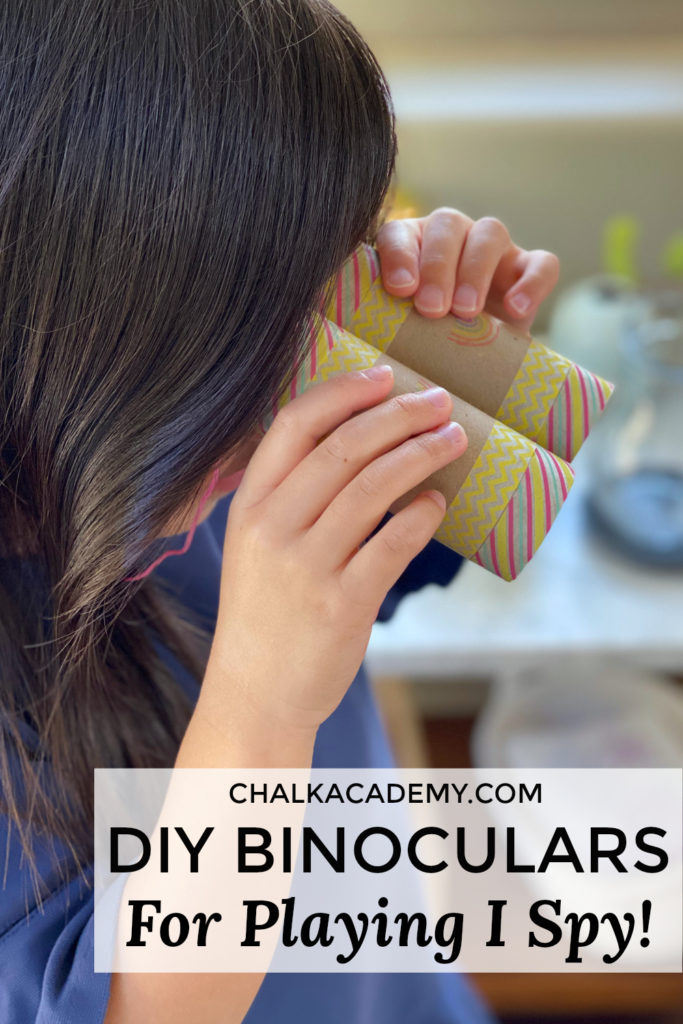
Describe part of an object and see if the other person can find what they are thinking of. In Mandarin Chinese, “I Spy” can be translated in a few ways:
- 我用眼睛偷瞄 (Wǒ yòng yǎnjīng tōu miáo / I use my eye to peek)
- 我用我的小眼睛看到一样_色的东西 / 我用我的小眼睛看到一樣_色的東西 (Wǒ yòng wǒ de xiǎo yǎnjīng kàn dào yīyàng___sè de dōngxī / I used my little eye to see a ___-colored thing)
- 猜,猜,猜猜看! 我看到___的东西 / 猜,猜,猜猜看! 我看到_的東西 (Cāi, cāi, cāi cāi kàn! Wǒ kàn dào___de dōngxī / Guess, guess, guess, guess if you can! I see a ___ thing).
4. Raise you hand if… (如果…举起手!/ 如果…举舉手! )

The “raise your hand game” works by asking everyone to raise their hand if they fit a certain characteristic. Takes turns asking questions to ask in Chinese to encourage kids to speak the minority language!
5. 20 Questions
First, think of a person, place, or thing. Then, share which of the three categories it belongs to. The other person can ask up to 20 close-ended, “yes” or “no” questions in Chinese!
6. Simon says / 老师说 / 老師說
One player takes on the role of “Simon” and gives instructions (eg, close your eyes, put your hand on your head) to the other players.
The actions should be performed only when prefaced with the phrase “Simon says” in English or 老师说 / 老師說 (Lǎoshī shuō / Teacher says) in Chinese.
Here’s a video of school children playing “老师说 / 老師說 (Lǎoshī shuō / Teacher says)” in Chinese!
7. Hot and cold hiding game
Since kids love to hide things and make us find them, you can turn that joy into a Chinese learning game! 越来越热,越来越冷 / 越來越熱,越來越冷 (yuè lái yuè rè, yuè lái yuè lěng / hotter and hotter, colder and colder) are clues to whether you are closer or farther from the hidden object.
Easy activities for Chinese Character reading practice
These simple, low-prep activities have helped my son and daughter memorize Chinese characters.
1. Post-It Note Chinese word matching
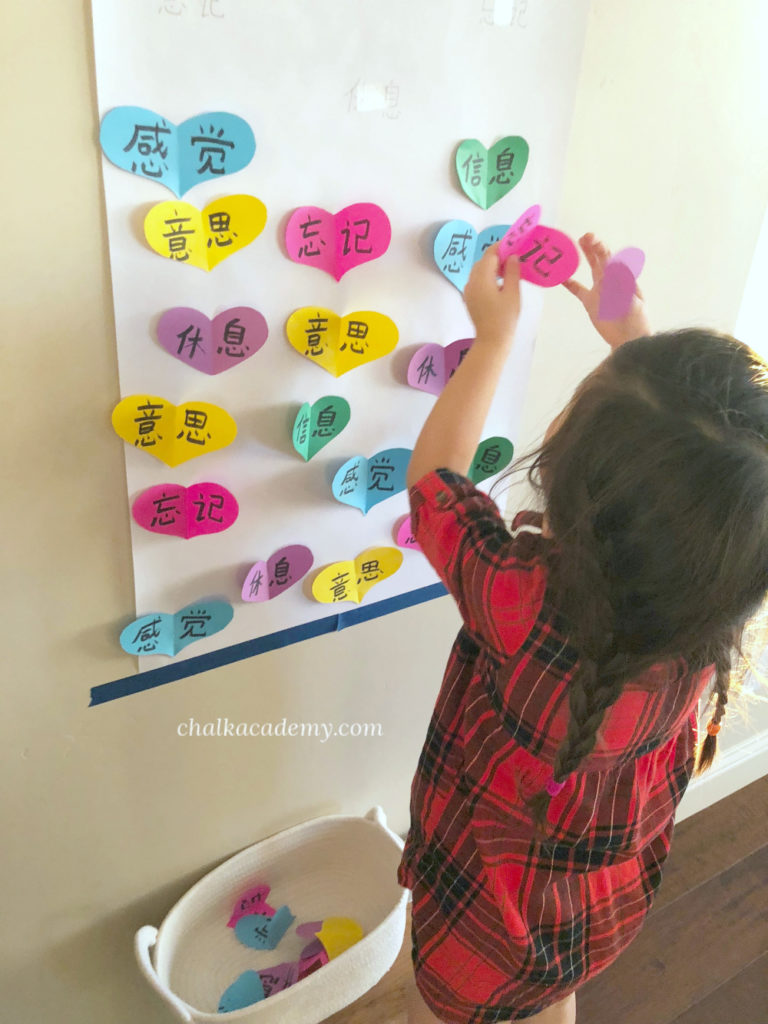
If you have Post-it notes at home, they can be easily turned into word-matching games!
2. Dot sticker Chinese word matching

Dot stickers can be easily transformed into Chinese character-matching activities. See 30 Chinese Dot Sticker Learning Activities for more examples.
3. Trace Chinese characters with small objects

For kids ages 3+ who are past the mouthing stage, small objects can be used for tracing Chinese characters. Use anything you have at home, such as scrap paper, leaves, seeds, pom poms, mini stickers, and small rocks. You can even use Cheerios, beans, and macaroni, which can later turn into their snack!
To create giant Chinese characters, type or copy/paste the focus word into Pages or Microsoft Word. Change the font to KaiTi font and increase the size as large as possible (eg, 460pt).
4. DIY tactile Chinese characters

To encourage kids to interact with each Chinese character stroke, make tactile Chinese characters with puffy paint or glue. Once dry, the texture is interesting to touch, which can help with remembering the Chinese word.
5. Flashlight word scavenger hunt

Turn off the lights…and find Chinese words with a flashlight. Switch this into a speaking game for kids not yet reading while shining the light on things you see.
6. Fishing Chinese flashcard game
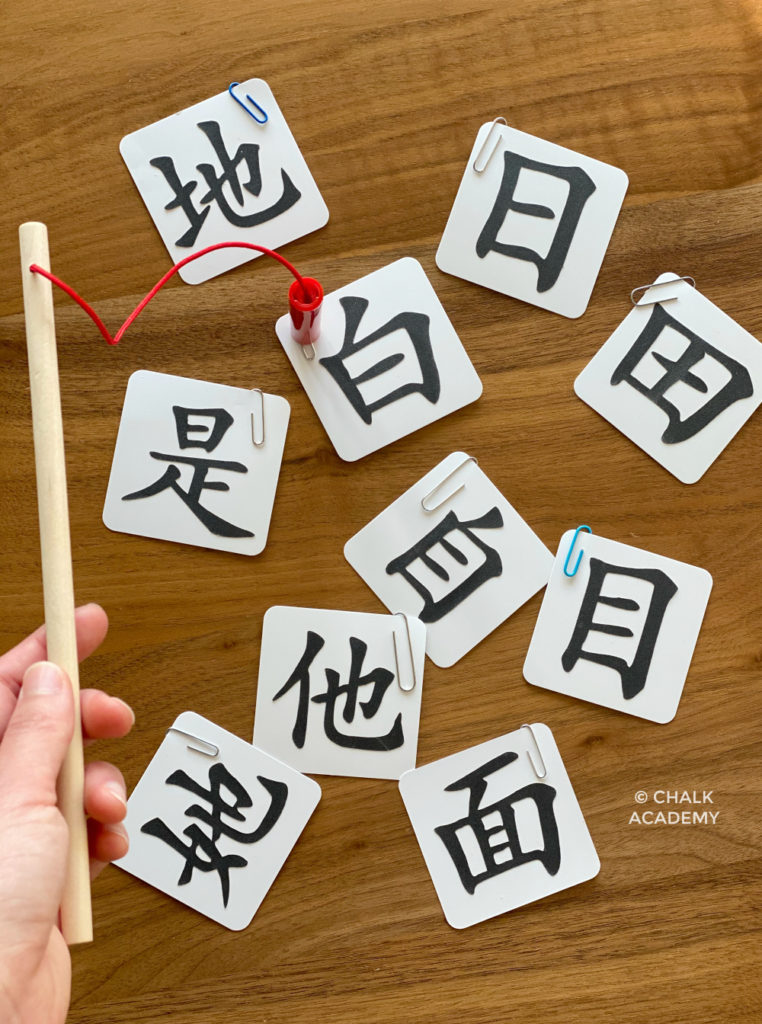
Fish for Chinese words by putting paper clips on flashcards and create a fishing rod with a stick, string, and magnet!
7. Swat-the-Chinese word

Get some energy out by smacking Chinese words with your hands or fly swatter!
8. Jump on Chinese words
Another fun way to get moving while learning! Use flashcards or Chinese words on post-it notes and have kids race to the Chinese word.
9. Post-It Note Tic-Tac-Toe

We’re obsessed with Post-It Notes, and you can turn it into a Chinese tic-tac-toe game!
10. Scratch off secret Chinese word
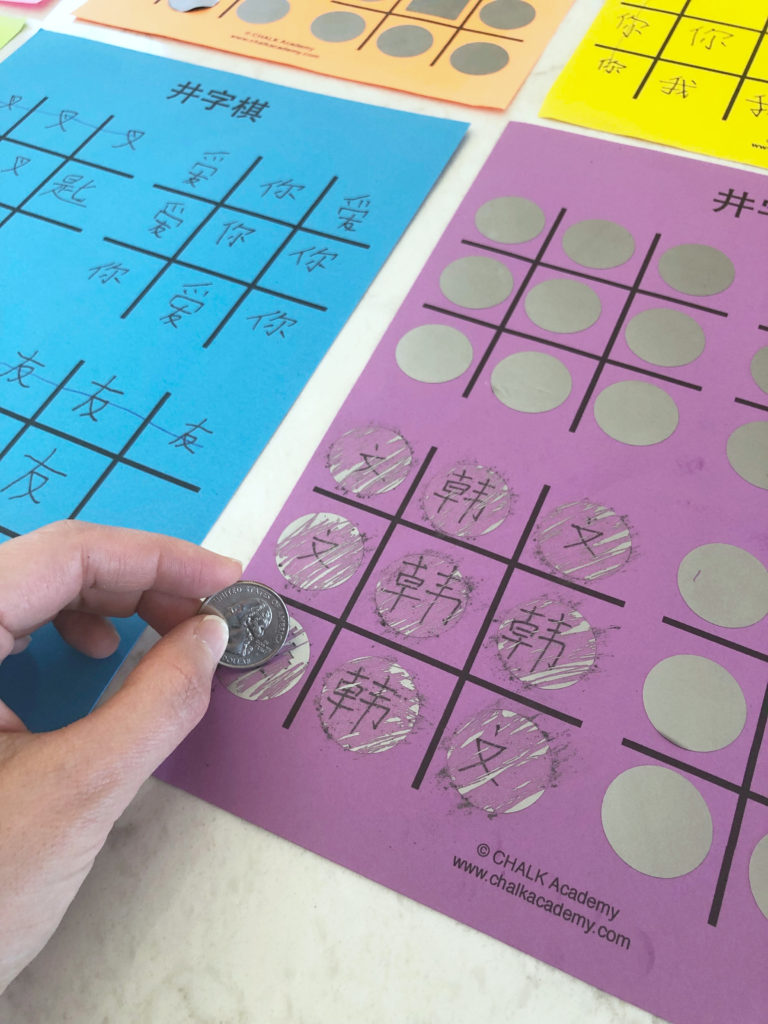
Create a secret message with scratch-off stickers!
11. Chinese hopscotch and other sidewalk chalk activities
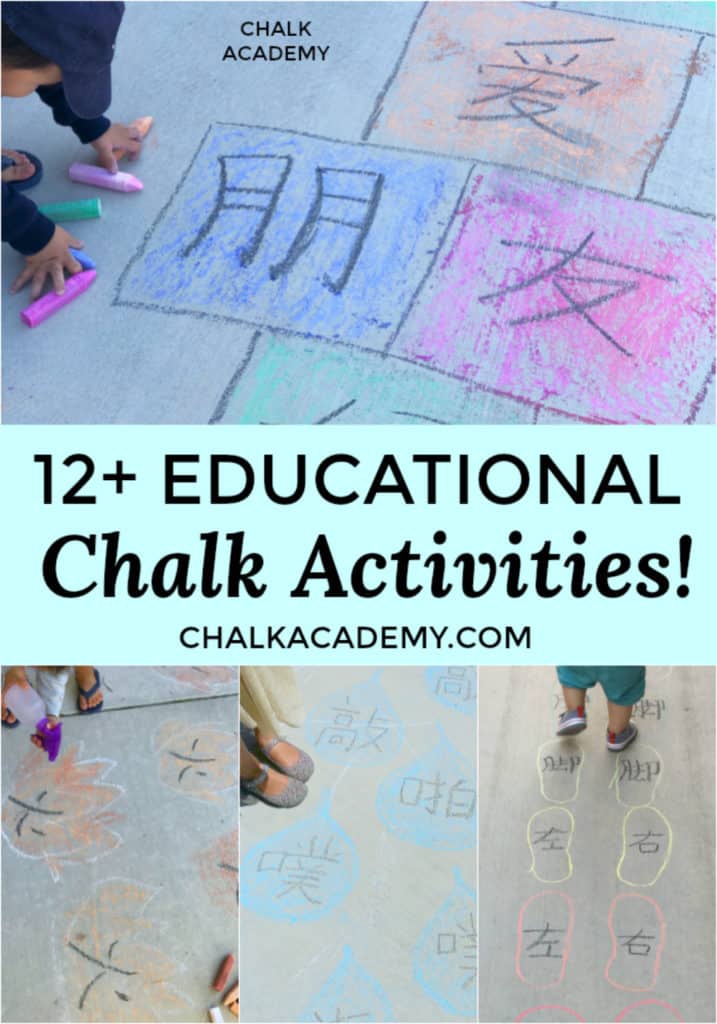
If you have a driveway or patio, write the words your kids are writing and have them jump or spray water on it. Here are 12 fun ways to play and learn Chinese with sidewalk chalk.
12. Sight word soccer

Do you have a backyard or live near a field? Try Chinese sight word soccer! Tape Chinese words into cones or trees and have fun kicking balls to each word.
13. Radicals wheel with toilet paper
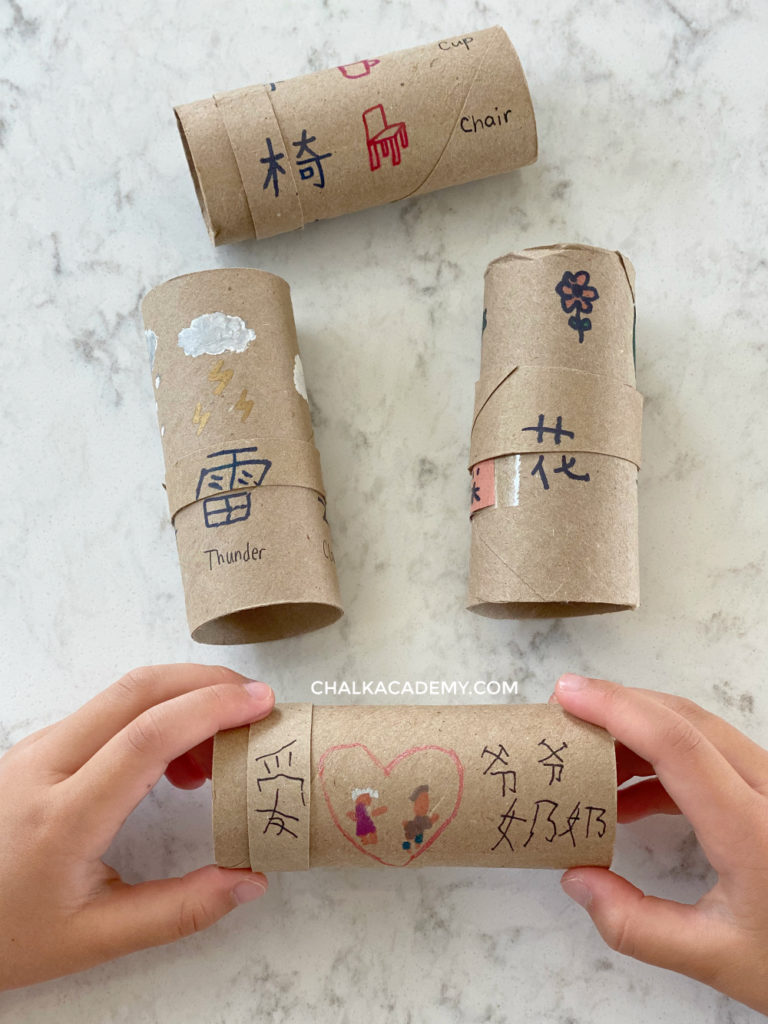
Inspired by a brilliant mom, Cathy, we made spinning radical wheels with cardboard toilet paper rolls! We’ve also done this with English CVC words and simple Korean CV sounds!
Try this: 20+ Chinese Learning Activities with Cardboard Rolls!
14. Envelope with Chinese sentence strips

I have written sentences for my kids to review Chinese characters in different contexts for spaced repetition reading practice.
Cut sentences into strips so kids can focus on one sentence at a time. (A full paragraph or page of words can be overwhelming and distracting.) Put the sentence strips in an envelope to practice reading surprise messages.
15. Lego word matching activity

Since many families have Legos, Duplos, and Megablocks at home, you can quickly repurpose them into word-matching activities!
Challenge older kids to build Legos in the shapes of Chinese characters.
16. Chinese character golf game

DIY Golf is an original activity created by my husband on a whim. In 5 minutes, he made a golf club with cardboard tubes while I quickly cut out mountains from green paper. For more ideas, check out these Fun Ways to Teach Chinese Characters 高山 with DIY Mountains.
17. DIY object puzzle

First, trace around objects with a pencil. Then, retrace the pencil lines with a black marker so the shape stands out better. Write a Chinese character at the center so your child can see it while matching the object.
18. Paint resist activities with wax, white crayon, or tape

Kids love seeing words magically appear after painting over the wax or white crayon and how the paint rolls away from the wax! Tips for wax-resist painting are explained here.
You can also try this with washi or painter’s tape. If you prefer to avoid paint, try using a marker.
19. Floating Chinese words!
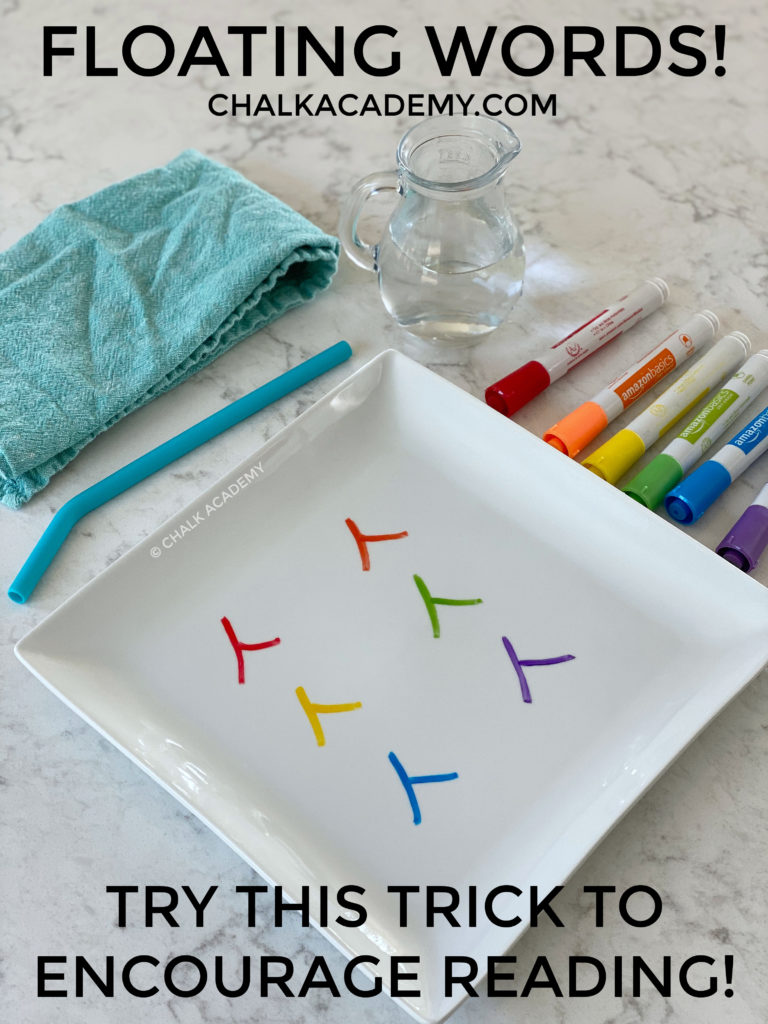
This activity with dry-erase whiteboard markers (also available at Michaels) works like magic. Because the ink is insoluble and less dense than water, Chinese characters can float!
- Write simple Chinese characters or alphabet letters (eg, Korean, English) on a clean, dry white plate. Firm, smooth strokes are best!
- Gently pour water next to the character/letter. If you pour directly on the character/letter, it might split.
- Then blow letters around!
- Rinse, dry, & repeat! Use alcohol as needed to remove residual marker ink from the plate.
The floating trick works best for characters/letters that are connected, but try all types with your kids. Whether we like it or not, trial and error is an important part of learning.
Easy activities for Chinese writing
1. Highlighter tracing writing practice
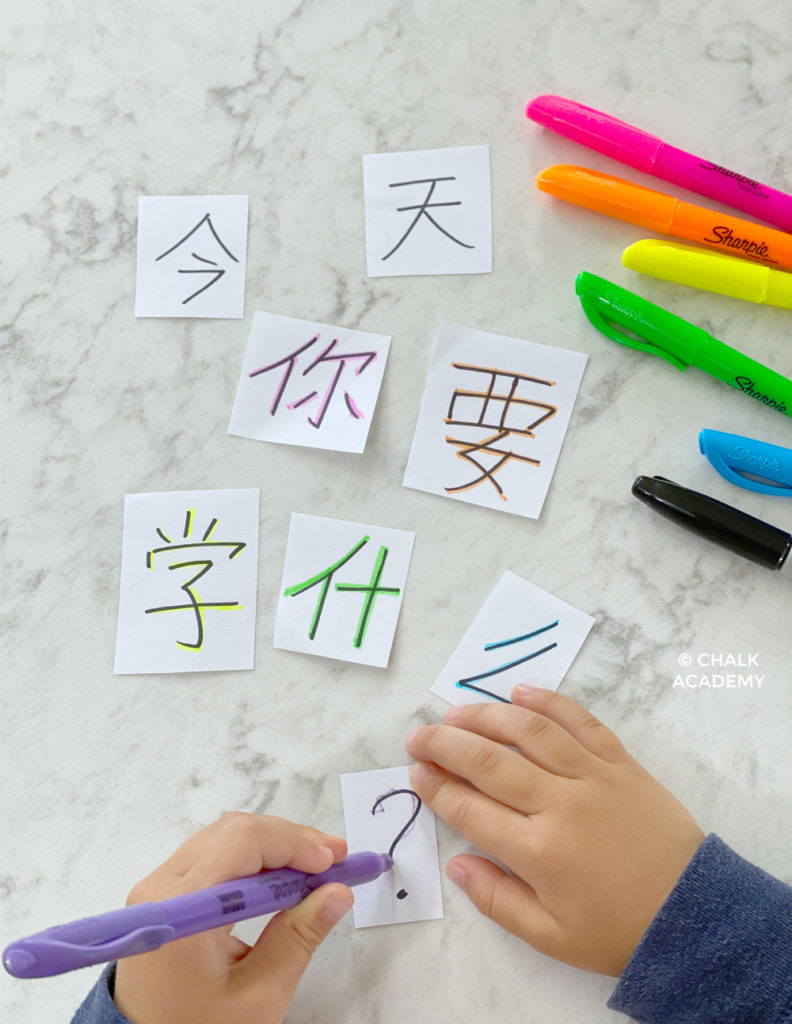
Write or print Chinese characters with black ink and invite your kids to trace over it with their favorite highlighter.
2. Salt or sand writing tray

Trace Chinese characters in a tray of salt. It’s as simple as it sounds! Tips for Montessori-inspired sensory writing here.
3. Play Chinese writing tic-tac-toe
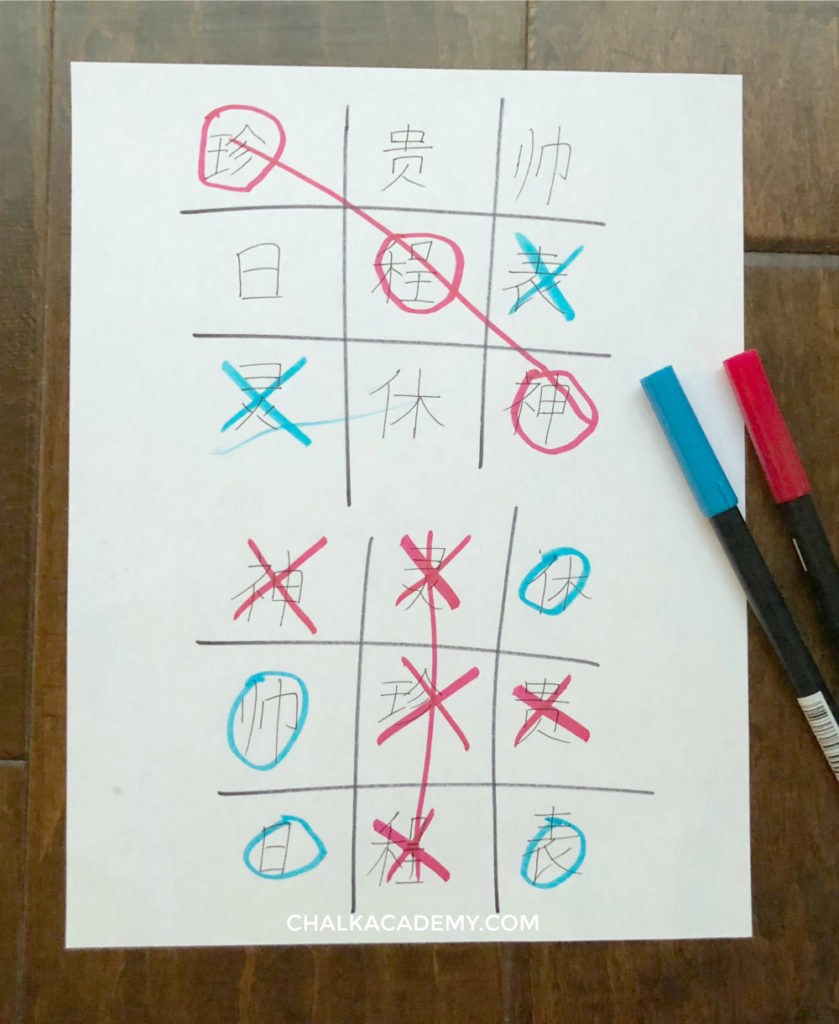
Tic-tac-toe is probably the Chinese writing game that my daughter plays most often. We can easily do this on scrap paper anywhere and also with chalk on our driveway.
4. Write a card/letter to friends/family
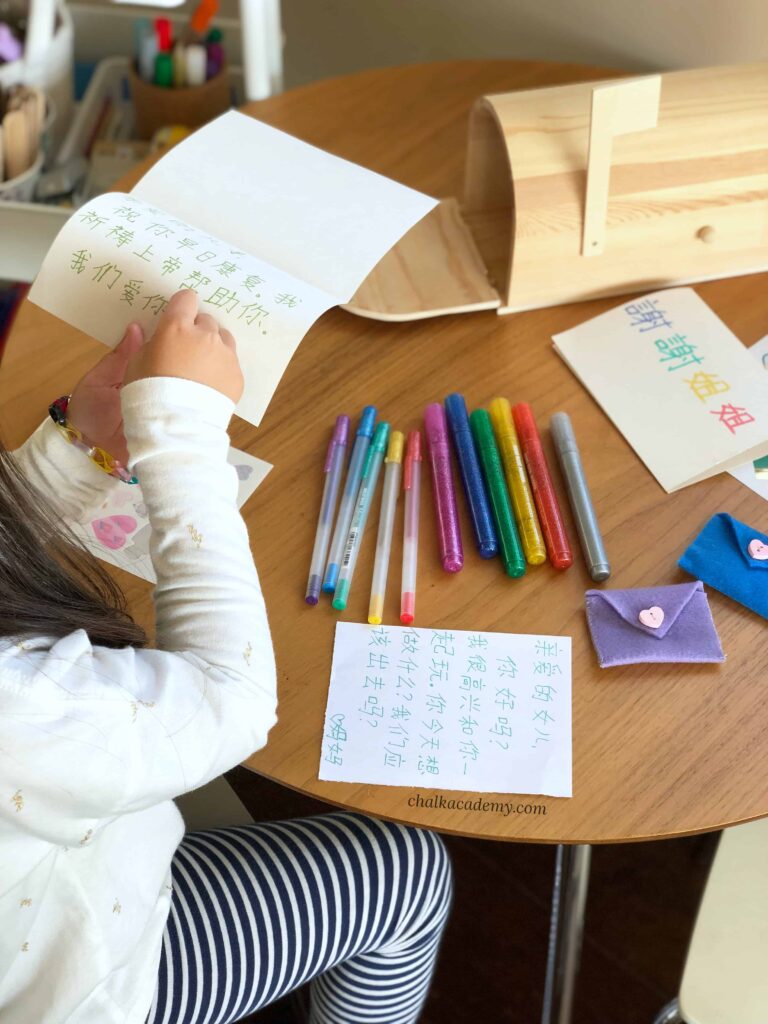
Do you have any birthdays or special occasions coming up? Make some cards for friends and family. See Handmade Cards for Reading and Writing Practice for examples of how to involve kids of all ages, from toddlers to teenagers.
5. Copy favorite Chinese song lyrics

Invite your child to copy their favorite Chinese song lyrics for a relaxing and therapeutic way to write Chinese. Learn copywork writing pratcice tips here.
Have you tried these easy Chinese learning activities with your kids or students?
If you try these Chinese activities, please let us know in the comments! What age(s) are your kid(s), and how did it go? We’d love to hear about your learning experience.
More tips for teaching kids Chinese
Children need an immersive environment with connection and curiosity to learn Chinese. Enjoy these popular resources!
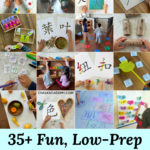
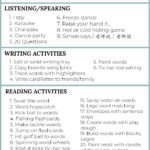




Nihao! Xie xie for sharing with great ideas out here. We are in lockdown and many many kids don’t really want to learn Chinese. Their families have limited resources at home. What do we do? I scratch my head everyday and have been trying to come up with learning tasks that are meaningful to these kids at home. IT IS DIFFICULT! Most of the kids I teach are not interested in learning Chinese at all and they have to …
Not sure what more to say as we live in a difficult world today and Chinese is NOT POPULAR any more due to the major political movements in the world today!
SAD!
Thank you so much for your sharing!
You’re welcome! 😀
How do you do the Chinese printables that have an outline of the character? Seems like that would be great for tracing work!
Hi! On the Pages app, I choose the “outline” typeface. Although I used outline font often with my oldest child, I actually would recommend using the regular solid black KaiTi font more often since it gives more visual input. I learned this concept from Montessori. Outline is fun for coloring or painting however! Hope that helps!